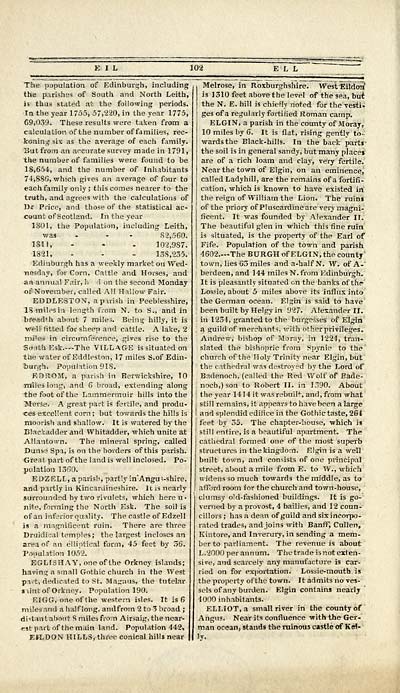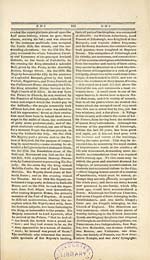Gazetteer of Scotland
(104) Page 102
Download files
Complete book:
Individual page:
Thumbnail gallery: Grid view | List view

I L
The population of Edinburgh, including
the parishes of South and North Leith,
is thus stated at the following periods.
In the year 1755, 57,220, in the year 1775,
69,039. These results were taken from a
calculation of the number of families, rec-
koning six as the average of each family.
Uutfrom an accurate survey made in 1791,
the number of families were found to be
18,654, and the number of Inhabitants
74,886, which gives an average of four to
each family only ; this comes nearer to the
truth, and agrees with the calculations of
l>r Price, and those of the statistical ac-
count of Scotland. In the year
1801, the Population, including Leith,
was - - - 82,560.
1811, - - - 102.9S7.
1821, - - - 138,235.
Edinburgh has a weekly market on Wed-
nesday, for Corn, Cattle and Horses, and
an annual Fair, h ;1 on the second Monday
of November, called All Hallow Fair.
EDDLESTON, a parish in Peeblesshire,
18 miles in length from N. to S., and in
bfead'.h about 7 miles. Being hilly, it is
■well fitted for sheep and cattle. A lake, 2
mites in circumference, gives rise to the
South Esk.— The VILLAGE is situated on
the water of Eddleston, 17 miles S.of Edin-
burgh. Population 91S.
EDilOJI, a parish in Berwickshire, 10
miles long, and 6 broad, extending along
the foot of the Lammermuir hills into the
Merse. A great part is fertile, and produ-
ces excellent corn; but towards the hills is
moorish and shallow. It is watered by the
Blackadder and Whitadder, which unite at
AHantown. The mineral spring, called
Dunse Spa, is on the borders of this parish.
Great part of the land is well inclosed. Po-
pulation 1360.
EOZELL, a parish, partly ;n"Angu;-shire,
and partly in Kincardineshire. It is nearly
surrounded by two rivulets, which here u-
nite, forming the North Esk. The soil is
of an inferior quality. The castle of Edzell
is a magnificent ruin. There are three
Druidical temples; the largest incloses an
area of an elliptical form, 45 feet by 36.
Population 1052.
EGLISHAY, one of the Orkney islands;
having a small Gothic church in the West
pa.'t, dedicated to St. Magnus, the tutelar
saint of Orkney. Population 190.
EIGG, one of the western isles. It is 6
miles and a half long, andfrom 2 to 3 broad ;
diitantabout Smilesfrom Airsaig, the near-
est part of the main land. Population 442,
EiLDON HILLS, throe conical hills near
, Melrose, in Roxburghshire. West Eildon
is 1 310 feet above the level of the sea, bui
I the N. E. hill is chiefly noted for the vesti-
! ges of a regularly fortified Roman camp.
ELGIN, a parish in the county of Moray,
10 miles by 6. It is flat, rising gently to-
wards the Black-hills. In the back parts
the soil is in general sandy, but many places
are of a rich loam and clay, very fertile.
Near the town of Elgin, on an eminence,
called Ladyhill, are the remains of a fortifi-
cation, which is known to have existed in
the reign of William the Lion. The ruins
of the priory of Pluscardineare very magni-
ficent. It was founded by Alexander II.
The beautiful glen in which this fine ruin
is situated, is the property of the Earl of
Fife. Population of the town and parish
4602.— The BURGH of ELGIN, the county
town, lies 63 miles anda-balfN. W. of A.'
berdeen, and 144 miles N.from Edinburgh.
It is pleasantly situated en the banks of the
Lossie, about 5 miles above its influx into
the German ocean. Elgin is said to have
been built by Helgy in 927. Alexander II.
in 1234, granted to the burgesses of Elgin
a guild of merchants, with other privileges.
Andrew, bishop of Moray, in 1224, tran-
slated the bishopric from Spynie to the
church of the Holy Trinity near Elgin, but
the cathedral was destroyed by the Lord of
Badenoch, (called the Red Wolf of Bade-
nocb,)son to Robert II. in 1390. About
the year 14 1 4 it was rebuilt, and, from what
still remains, it appears to have been a large
and splendid edifice in the Gothic taste, 264
feet by 35. The chapter-house, which is
still entire, is a beautiful apartment. The
cathedral formed one of the most superb
structures in the kingdom. Elgin is a well
built town, and consists of one principal
street, about a mile from E. to W., which
widens so much towards the middle, as to
afford room for the church and town-house,
clumsy old-fashioned buildings. It is go-
verned by a provost, 4 bailies, and 12 coun-
cillors ; has a dean of guild and six incorpo-
rated trades, and joins with Banff, Cullen,
Kintore, and Inverury.in sending a mem-
ber to parliament. The revenue is about
L.2000 per annum. The trade isnot exten-
sive, and scarcely any manufacture is car-
ried on for exportation. Lossie-mouth is
the property of the town. It admits no ves-
sels of any burden. Elgin contains nearly
4000 inhabitants.
ELLIOT, a small river in the county of
Angus. Near its confluence with the Ger-
man ocean, stands the ruinous castle of Kel-
ly.
The population of Edinburgh, including
the parishes of South and North Leith,
is thus stated at the following periods.
In the year 1755, 57,220, in the year 1775,
69,039. These results were taken from a
calculation of the number of families, rec-
koning six as the average of each family.
Uutfrom an accurate survey made in 1791,
the number of families were found to be
18,654, and the number of Inhabitants
74,886, which gives an average of four to
each family only ; this comes nearer to the
truth, and agrees with the calculations of
l>r Price, and those of the statistical ac-
count of Scotland. In the year
1801, the Population, including Leith,
was - - - 82,560.
1811, - - - 102.9S7.
1821, - - - 138,235.
Edinburgh has a weekly market on Wed-
nesday, for Corn, Cattle and Horses, and
an annual Fair, h ;1 on the second Monday
of November, called All Hallow Fair.
EDDLESTON, a parish in Peeblesshire,
18 miles in length from N. to S., and in
bfead'.h about 7 miles. Being hilly, it is
■well fitted for sheep and cattle. A lake, 2
mites in circumference, gives rise to the
South Esk.— The VILLAGE is situated on
the water of Eddleston, 17 miles S.of Edin-
burgh. Population 91S.
EDilOJI, a parish in Berwickshire, 10
miles long, and 6 broad, extending along
the foot of the Lammermuir hills into the
Merse. A great part is fertile, and produ-
ces excellent corn; but towards the hills is
moorish and shallow. It is watered by the
Blackadder and Whitadder, which unite at
AHantown. The mineral spring, called
Dunse Spa, is on the borders of this parish.
Great part of the land is well inclosed. Po-
pulation 1360.
EOZELL, a parish, partly ;n"Angu;-shire,
and partly in Kincardineshire. It is nearly
surrounded by two rivulets, which here u-
nite, forming the North Esk. The soil is
of an inferior quality. The castle of Edzell
is a magnificent ruin. There are three
Druidical temples; the largest incloses an
area of an elliptical form, 45 feet by 36.
Population 1052.
EGLISHAY, one of the Orkney islands;
having a small Gothic church in the West
pa.'t, dedicated to St. Magnus, the tutelar
saint of Orkney. Population 190.
EIGG, one of the western isles. It is 6
miles and a half long, andfrom 2 to 3 broad ;
diitantabout Smilesfrom Airsaig, the near-
est part of the main land. Population 442,
EiLDON HILLS, throe conical hills near
, Melrose, in Roxburghshire. West Eildon
is 1 310 feet above the level of the sea, bui
I the N. E. hill is chiefly noted for the vesti-
! ges of a regularly fortified Roman camp.
ELGIN, a parish in the county of Moray,
10 miles by 6. It is flat, rising gently to-
wards the Black-hills. In the back parts
the soil is in general sandy, but many places
are of a rich loam and clay, very fertile.
Near the town of Elgin, on an eminence,
called Ladyhill, are the remains of a fortifi-
cation, which is known to have existed in
the reign of William the Lion. The ruins
of the priory of Pluscardineare very magni-
ficent. It was founded by Alexander II.
The beautiful glen in which this fine ruin
is situated, is the property of the Earl of
Fife. Population of the town and parish
4602.— The BURGH of ELGIN, the county
town, lies 63 miles anda-balfN. W. of A.'
berdeen, and 144 miles N.from Edinburgh.
It is pleasantly situated en the banks of the
Lossie, about 5 miles above its influx into
the German ocean. Elgin is said to have
been built by Helgy in 927. Alexander II.
in 1234, granted to the burgesses of Elgin
a guild of merchants, with other privileges.
Andrew, bishop of Moray, in 1224, tran-
slated the bishopric from Spynie to the
church of the Holy Trinity near Elgin, but
the cathedral was destroyed by the Lord of
Badenoch, (called the Red Wolf of Bade-
nocb,)son to Robert II. in 1390. About
the year 14 1 4 it was rebuilt, and, from what
still remains, it appears to have been a large
and splendid edifice in the Gothic taste, 264
feet by 35. The chapter-house, which is
still entire, is a beautiful apartment. The
cathedral formed one of the most superb
structures in the kingdom. Elgin is a well
built town, and consists of one principal
street, about a mile from E. to W., which
widens so much towards the middle, as to
afford room for the church and town-house,
clumsy old-fashioned buildings. It is go-
verned by a provost, 4 bailies, and 12 coun-
cillors ; has a dean of guild and six incorpo-
rated trades, and joins with Banff, Cullen,
Kintore, and Inverury.in sending a mem-
ber to parliament. The revenue is about
L.2000 per annum. The trade isnot exten-
sive, and scarcely any manufacture is car-
ried on for exportation. Lossie-mouth is
the property of the town. It admits no ves-
sels of any burden. Elgin contains nearly
4000 inhabitants.
ELLIOT, a small river in the county of
Angus. Near its confluence with the Ger-
man ocean, stands the ruinous castle of Kel-
ly.
Set display mode to: Large image | Transcription
Images and transcriptions on this page, including medium image downloads, may be used under the Creative Commons Attribution 4.0 International Licence unless otherwise stated. ![]()
| Gazetteers of Scotland, 1803-1901 > Gazetteer of Scotland > (104) Page 102 |
|---|
| Permanent URL | https://digital.nls.uk/97422942 |
|---|

